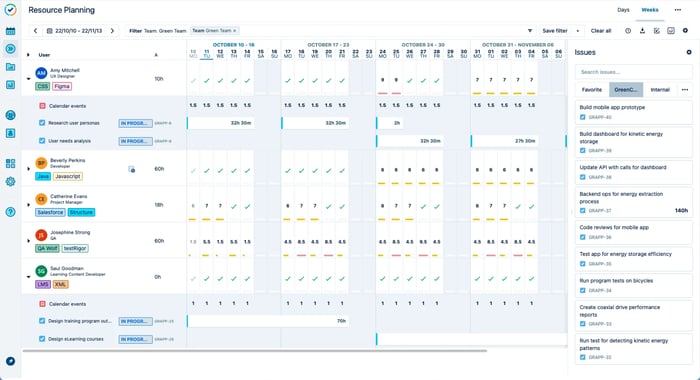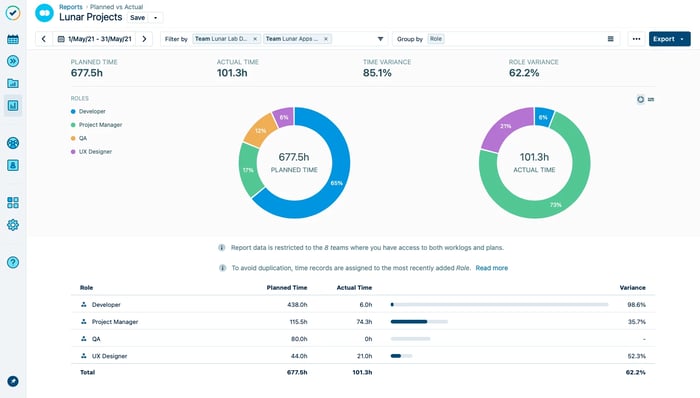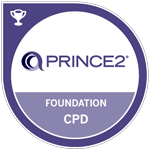Resource Planning
Proactive resource planning is the key to effective project management. Good resource planning is a rich mix of process, technology, and automation. This helps companies work more efficiently by assigning the right people, time, and tools to a project and making sure that high-impact projects can succeed.
Get started!
What is resource planning?
Resource planning is the process of the systematic organization, prediction, and allocation of various resources such as personnel, time, materials, tools, equipment, and supplies to a project while keeping in mind factors such as timing and cost. By implementing effective resource planning strategies, businesses can optimize the use of their available resources and enhance productivity and efficiency. With good resource planning, organizations can ensure that their resources are used in a streamlined and cost-effective manner, resulting in enhanced profitability and growth.
Why resource planning is so important?
Resource planning is an essential aspect of project management, and its importance cannot be overstated. It enables project managers to allocate resources strategically, ensuring that they are utilized where they can have the greatest impact on the organization's objectives. Without effective resource planning processes in place, it is difficult to determine the optimal allocation of employees and other resources, leading to a lack of visibility in terms of where to shift resources to maximize impact.
By implementing an effective resource planning process, organizations can determine the optimal mix of resources required to complete a project based on its specific demands, taking into account factors such as its requirements, constraints, and opportunities. Additionally, resource planning helps identify potential mismatches in terms of resources and demands, enabling the organization to address these issues proactively.
Moreover, a good resource planning process facilitates on-time and on-budget project delivery by ensuring that the necessary resources are available when and where they are needed. By prioritizing resource planning, organizations can achieve better productivity and profitability and stay ahead of the competition.
How resource planning and management software can guide your next project’s success?

Meet Planner by Tempo – Resource Planning & Capacity Planning!
When it comes to optimizing capacity and organizing workloads, there’s nothing like Tempo Planner to get the job done. Tempo Planner is an effective and efficient resource planning and capacity reporting tool that give you visibility into one of your most valued assets: time. It provides a critical view across your organization to allow for effective decisions based on real-time data rather than static calendars. You can even plan time for multiple resources on a single Jira issue.
Plan future work more accurately
Use data from past projects to refine Jira resource planning. Compare actual time worked in Tempo Timesheets with original estimates from Tempo Planner. Better understand effort variance so you can continuously improve.

Why using the Tempo Planner might be a better choice compared to Excel?
While Excel can be a useful tool for resource planning, it does have its limitations. Tempo Planner can provide a more efficient and streamlined resource planning process than Excel, allowing your organization to make the most of its resources and achieve its goals. Here are a few reasons:
Centralized data
The Tempo Planner provides a centralized location for all your resource planning data, making it easy to manage and access. With Excel, managing multiple spreadsheets can become time-consuming and lead to errors.

Customization
The Tempo Planner can be customized to fit your specific business needs, allowing you to track the data that is most relevant to your organization. Excel, on the other hand, may require a significant amount of time and effort to set up.
Automation
The Tempo Planner automates many of the resource planning processes, freeing up time for you to focus on other important tasks. Excel requires more manual input, which can be time-consuming and prone to errors.
Collaboration
The Tempo Planner allows for real-time collaboration, enabling team members to work together on resource planning tasks. Excel files, on the other hand, can be difficult to share and collaborate on in real-time.
Resource planning is a critical process in any business or organization, as it involves managing and allocating resources such as time, money, personnel, equipment, and materials in the most effective and efficient way possible. Here are some important things to keep in mind when it comes to resource planning:
-
Prioritization: Resource planning involves prioritizing which projects or tasks are most important and ensuring that resources are allocated accordingly.
-
Real-time monitoring: Real-time monitoring of resources is essential to ensure that everything is on track and that any issues or potential roadblocks are identified and addressed as quickly as possible.
-
Flexibility: Resource planning requires flexibility and the ability to adapt to changing circumstances or unexpected events that may affect resource availability or allocation.
-
Collaboration: Effective resource planning requires collaboration between different teams or departments to ensure that everyone is working towards the same goals and that resources are being used optimally across the organization.
-
Technology: Resource planning software and tools can significantly streamline the resource planning process and help businesses to optimize their resource allocation and management.
By keeping these key considerations in mind, businesses can ensure that they are making the most of their available resources and achieving their goals in the most efficient and effective way possible.
What is important to know about resource planning?
Resource planning is a critical process in any business or organization, as it involves managing and allocating resources such as time, money, personnel, equipment, and materials in the most effective and efficient way possible.
Here are some important things to keep in mind when it comes to resource planning:
Prioritization
Resource planning involves prioritizing which projects or tasks are most important and ensuring that resources are allocated accordingly.
Real-time monitoring
Real-time monitoring of resources is essential to ensure that everything is on track and that any issues or potential roadblocks are identified and addressed as quickly as possible.
Resource planning requires flexibility and the ability to adapt to changing circumstances or unexpected events that may affect resource availability or allocation.
Collaboration
Effective resource planning requires collaboration between different teams or departments to ensure that everyone is working towards the same goals and that resources are being used optimally across the organization.
By keeping these key considerations in mind, businesses can ensure that they are making the most of their available resources and achieving their goals in the most efficient and effective way possible!
Stages of cost tracking

Preliminary planning
The project team gathers data to create an estimate. Potential resources are identified and elements such as labor, software, and other materials are considered.
Budgeting
The information from the pre-planning is used to create a project estimate that is approved by key stakeholders. This estimate is used to measure actual costs so the team can see how the project is progressing.
Cost control helps project managers get the right amount of money to ensure the project runs smoothly and successfully. Cost control is necessary for items such as materials, equipment, software, vendor invoices, timesheets, and contingencies.
Expense tracking
Budget tracking captures all expenses and how they relate to the baseline budget. Tracking these costs allows the team to understand how the project fits into the budget and where adjustments need to be made.
Communicate with relevant team members and stakeholders what has changed about the project or its budget. This will allow the project manager to document and justify any changes that have been made.
Continuous improvement
Tracking costs improves how the team executes projects and also provides transparency for everyone involved in project completion.
Used Software:

EazyBI for Jira
Tempo Timesheets - Jira Time Tracking

BigPicture
STAGIL Assets

Jira Software
Jira Service Management
Tempo Planner – Resource Planning & Capacity Planning
Cost Tracker for Tempo Timesheets
Tempo Budgets
Timesheet Reports & Gadgets
/Power-BI-Connector-for-Jira-logo.png?length=128&name=Power-BI-Connector-for-Jira-logo.png)
Power BI Connector for Jira
sumUp for Jira
Related Solutions:
Project Management
Business Processes
Cost tracking
catworkx Services

Consulting
Licensing

Trainings
Your point of contact:
Sarah Antrop

Specialization:
Would you like to improve your business's financial health with cost tracking?
We would be happy to help you achieve this.
The initial consultation is non-binding and free of charge!







.png?length=180&name=ITIL%20Foundation%20(2).png)





